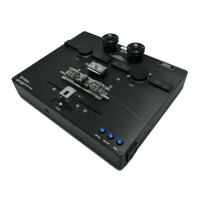FFS2000 Series Chapter 8: Recoat
Rev B, July 21, 2017 Page 51
Chapter 8 Recoat
8.1. Manual Injection System
The purpose of the recoat is to maintain the strength and flexibility of the fiber or fusion splice by protecting the
glass surface from damage. It should be noted that recoating a splice does not make the splice stronger.
To recoat a fusion splice, the section of exposed fiber in its FHB is placed in the quartz recoat mold assembly. To
allow for tolerance variations from the fiber manufacturer, the diameter of the recoat mold cavity is generally
specified to be slightly larger than the nominal outside coating diameter (e.g. 280 μm for a nominal 250 μm
coating). A liquid acrylate material is injected into the mold cavity and is cured by exposure to ultraviolet light from
a built-in UV source. The recoat process maintains a near original fiber diameter and delivers a flexible fusion
splice that can be handled or tightly coiled as if no splice were present.
8.2. Setting Up
It is important to check the following items before beginning the recoat process.
Recoat Time
This is the time the four halogen bulbs located below the recoat mold will be on during UV curing. Check the value
displayed in the Configuration Recoater menu. If a recoat time other than that displayed is needed, enter the
new value. Only integer values will be accepted. The default recoat time is 15 seconds.
Clean the Recoat Mold
The recoat mold assembly contains two very flat quartz plates, each with a semi-circular channel running
longitudinally down the center of their mating surfaces. One plate is mounted in the hinged top which, when
closed, forms a circular mold cavity with the bottom plate. In order for the top and bottom plates to mate flush
together, they must be cleaned of all dirt and/or coating particles.
The quartz mold plates can be cleaned with a soft lint-free lens tissue wetted with isopropyl alcohol. Wipe off any
dirt particles from both the top and bottom plates. The soft brush provided can be used to clean the mold
channels of any cured coating particles. Coating particles that adhere to the mold plates can be softened with
acetone if necessary. Do not rub any hard objects across the surface of the plates as this could scratch the optical
coating.
The mold should be replaced if there are chips along the recoat length, which can be observed using an eye
loupe. The recoated fiber can also be observed; excessive flashing will be evident if the mold is not aligned or has
excessive chipping.
UV Acrylate Level in the Injection Port
For users who only occasionally recoat fiber, we recommend using the injection plunger with a syringe to inject
the acrylate into the mold. The top quartz plate contains an injection port which must be filled with UV acrylate
material (supplied) prior to placing the fiber in the recoat mold. The injection port can be filled by using a syringe
(supplied) to dispense the UV material. Care must be taken to prevent the formation of bubbles in the UV material
when loading both the syringe and the injection port.
WARNING
Prior to handling the UV acrylate material, be sure to read the Material Safety Sheet for your material.
MSDS for UV acrylate material purchased from Thorlabs can be found by visiting www.thorlabs.com
and searching for the Thorlabs’ Item #.
!
!

